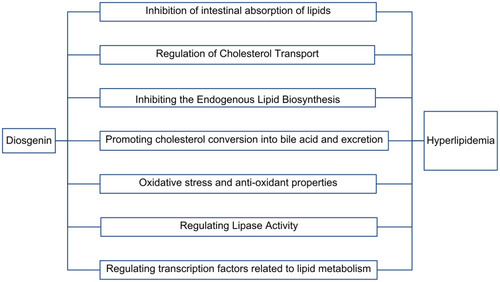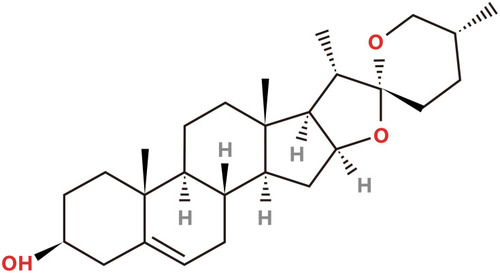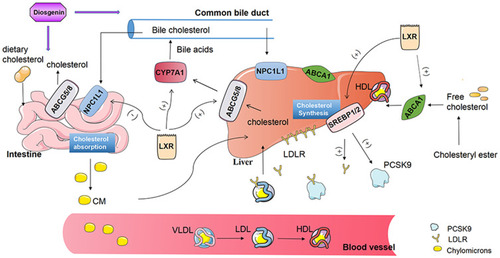Figures & data
Figure 1 The mechanism of diosgenin on lipid metabolism. As shows, the paper will elaborate the lipid metabolism regulating mechanism of diosgenin in detail. It includes diosgenin’s effects on inhibiting intestinal absorption of lipids, regulation of cholesterol transport, promoting cholesterol conversion into bile acid and excretion, inhibiting the endogenous lipid biosynthesis, effect on antioxidation, regulating lipoprotein lipase activity, and regulating transcription factors related to lipid metabolism.

Figure 2 Chemical structure of diosgenin. Its molecular formula is C27H42O3, density is 1.1±0.1g/cm3, and relative molecular mass is 414.63.

Table 1 The Effect of Diosgenin on Markers Relevant to Lipid Metabolism
Figure 3 Schematic representation of molecular mechanisms of diosgenin attenuates cholesterol metabolism. As shown in the figure, diosgenin can inhibit cholesterol intake of human liver and intestinal cells mediated by NPC1L1. Diosgenin regulates lipid homeostasis by inhibiting the expression of a series of enzymes needed by SREBPs to affect endogenous cholesterol, fatty acid, triglyceride and phospholipid synthesis. LDLR is the transcriptional target of SREBP2, diosgenin can enhance LDLR mediated uptake of cholesterol by peripheral cells from the circulation. Notably, Diosgenin may also inhibit PCSK9 mediated lysosomal degradation of PCSK9-LDLR complex and avoid LDL accumulation in vivo. Diosgenin can promote ABCA1 mediated RCT process, promote cellular efflux of phospholipids and cholesterol to lipid-poor apolipoproteinA-1 (apoA-1) and removal of excess cholesterol. ABCG 5/G 8 is activated by diosgenin, which promotes the secretion of unesterified free cholesterol into the bile canaliculus or gut lumen for fecal excretion and prevents the accumulation of sterols in diet. In addition, CYP7A1 was activated by diosgenin to catalyze the conversion of accumulated cholesterol to primary bile acids in liver. At present, whether diosgenin can regulate cholesterol metabolism through LXRs is not very clear. (+) promotion, (–) inhibition.

